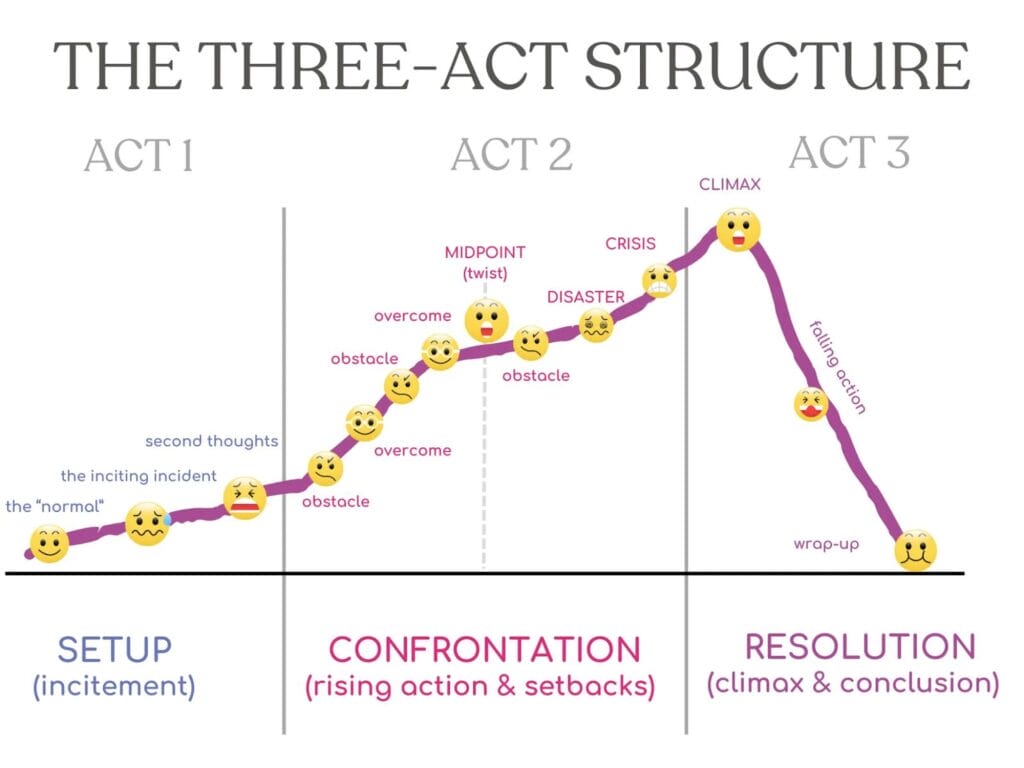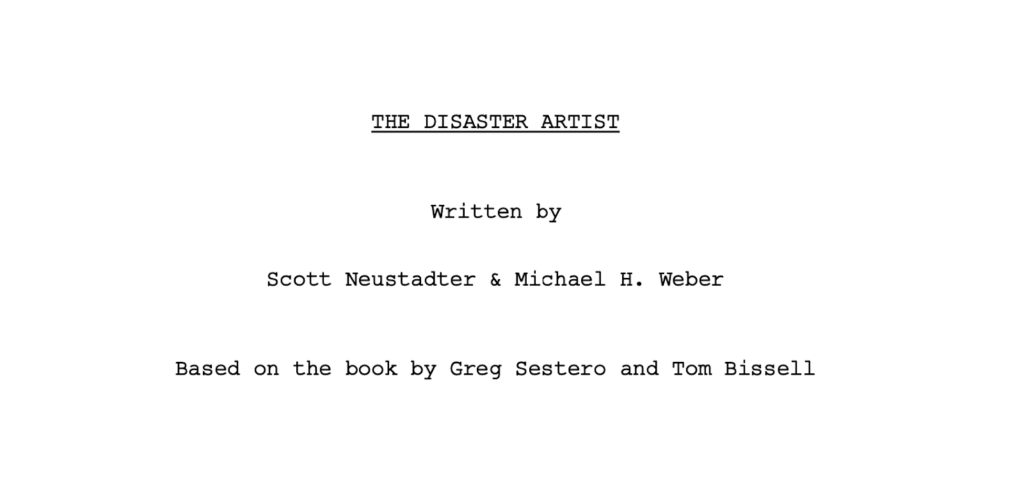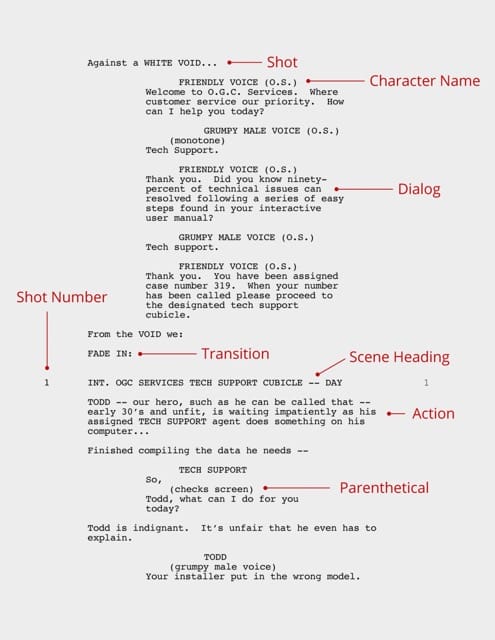Screenplays are the written foundation for television shows, movies, and other on-screen media. Not only do screenplays include dialogue for characters, but other elements like direction and editing specifications—screenplays are the blueprint for production, direction, acting, and editing from the writer.
Even if you’re a novelist or writer of other genres, screenplays can be fun to write as well as informative and educational for other forms of writing.
Just like writing poetry can improve imagery and language in prose, thinking of a story through the lens of film can give you a new perspective on written fiction.
Here are some basic steps you might consider as you learn how to write a screenplay.
1. Read Other Screenplays
A screenplay is a bit different from other formats, so if you aren’t already familiar with them, read tons of screenplays to understand how they work. It can be helpful to read the screenplays for movies or shows you’re already familiar with. It’s interesting to see how the writer’s original vision translated to screen.
2. The Big Idea
What’s your premise? Before you begin writing is a great time to do some brainstorming to develop a unique, interesting concept for your screenplay. You should consider genre, themes, and the overall message you’d like to convey. Your brainstorming session(s) may also cover character generation, setting development, plot points, lines of dialogue, and anything else that comes to mind. Write it all down!
3. Outline/Storyboard
I think this is one of the most fun parts of developing any format of story—create an outline or storyboard to organize your thoughts. This is where you should identify the key plot points, sketch out your character arcs, and grab an understanding of the overall structure of your story.
4. Character Development
Map out your character journeys, develop their personalities and motivations. Consider how each character will interact with and impact both the plot and other characters.
Where do they start the story, and where do they end up?
Build round characters, including your protagonist, antagonist/villain, and supporting cast.
5. Three-Act Structure
You might divide your story into three acts—setup, confrontation, and resolution. In Act One, you introduce your characters and the world, plus the inciting incident. In Act Two, you develop the conflict, have the characters overcome obstacles, and supply rising action that leads to the crisis. Act Two is your resolution, where the climax is hit, and we see the falling action, wrapping it up all happy (or devastating).

6. Scene-by-Scene Outline
Creating a scene-by-scene outline can help you to really test the story, highlight plot holes, and make bigger edits before you get too involved in the actual writing. You should ensure that each scene in some way contributes to the story—advancing the plot, developing characters, establishing the theme, or some combination of the three. This strategy can make the writing process much more streamlined and a lot quicker.
7. Write It!
Get writing! You might use software like Final Draft or another screenwriting tool to help you with formatting (which we’ll cover next). Tangentially—I looked up Adobe Story to include here, but it was discontinued in 2018?! Crushed. That was my favorite script drafter. Anyway.
Dialogue is the most important part of a script, since it’s usually the part that is most directly maintained throughout production. Your dialogue should be natural, engaging, and unique to that character’s voice.
Remember that a screenplay is ultimately a visual medium. Keep in mind what would be possible to film when writing actions, describe what needs description in a specific yet interpretable way, and don’t be afraid to be creative with your scene directions. Describe the locations, actions, and emotions in a way that can be translated to real life and the screen.
8. Keep Scene Direction Engaging
It’s easy to do the bare minimum in non-dialogue writing when you’re writing a screenplay, but if you’re trying to sell a script, it’s important to make the entire read engaging and interesting. You can get prosey with your descriptions, as long as you’re using it to enhance the idea, not confuse it.
Here’s the opening of the script for Forrest Gump (1994):

Saying a character “looks like he smells like fish” is SO descriptive and specific, while also being an intriguing way to describe him. They could have described his clothes, or his hair, or whatever elements of the man make him look like he smells like fish, but that’s a little heavy-handed. That description leaves the interpretation up to the director and costume department, because a writer is good at writing—the visual specifics to convey that idea are usually best left to the filmmakers and on-set creatives.
9. Formatting
There are many specific rules to formatting a screenplay. These rules can occasionally change and evolve, so check into the specifics for your region, genre, and other qualifiers.
Basics
In general, these are the font and margin specifics, though many writers don’t follow these to the comma.
- 12-point Courier font
- 1.5 inch margin on the left
- 1 inch margin on the right
- 1 inch margin top and bottom
- The dialogue blocks start 2.5 inches from the left side of the page
- Character names are uppercased and start 3.7 inches from the left side
- Page numbers are in the upper right corner with a 0.5 inch margin from the top
- Page numbers end with a period
- The first page is not numbered
Title page
Include a title page with your script title, your name, and contact information. You might include information, like the source material if it is an adaptation. Here’s the title page from The Disaster Artist (2017):

Dialogue
Your dialogue should be preceded by the character’s name in ALL CAPS character names. The dialogue appears one line below the character name. It does not use traditional dialogue tags.
Scene headings
The scene heading, also called a slug line, establishes the location and time of day your scene takes place. It begins with either EXT. or INT. to indicate if the location is inside or outside. Then it tells us where we are, either specifically or vaguely—TINA’S APARTMENT or AN ISLAND SOMEWHERE IN THE ATLANTIC. After a hyphen, we get a time indicator, like NIGHT, DAY, TEN MINUTES LATER. The entire scene heading is capitalized, and every scene has one.
Action lines
Your action lines tell us what’s happening in the scene. These sentences are formatted grammatically correct, with punctuation and capitalization. Again, keep in mind what is physically and realistically possible to perform. In fiction, we have a lot more freedom here, but most on-screen media productions will be more limited.
Transition
Transitions are editing directions for swapping between scenes. It could be FADE OUT, JUMPCUT, SMASH CUT, etc. These specifications can be used to indicate tone, humor, drama, and other vibes. Transitions are important to the screenplay writing process, as one more tool for the screenwriter to convey their vision.
Extension
An extension appears after the character’s name, within parentheticals, and as an initial. It indicates where the character is speaking from, if not on screen. Like (V.O.) for voiceover.
Parenthetical
The parenthetical occurs inside of dialogue, specifying how the line should be performed. These are used sparingly.
Here’s an example from B&H to illustrate these formatting techniques:

Screenplays are typically written with the above rules for a standardized format. If your intention is to sell the script, it would be wise to adhere to those industry conventions. While scripts are art, just like any other writing, we do get a bit more technical with them.
A screenplay is a tool that the production team will use from beginning to end. It will undergo revisions and changes throughout the process, and it acts as the guiding light for everyone involved in the production.
Next Step
Write, write, write! And use the techniques I’ve shared to write your screenplay.
If you’re exploring your options for publication, click the image below to schedule a call with our team.
